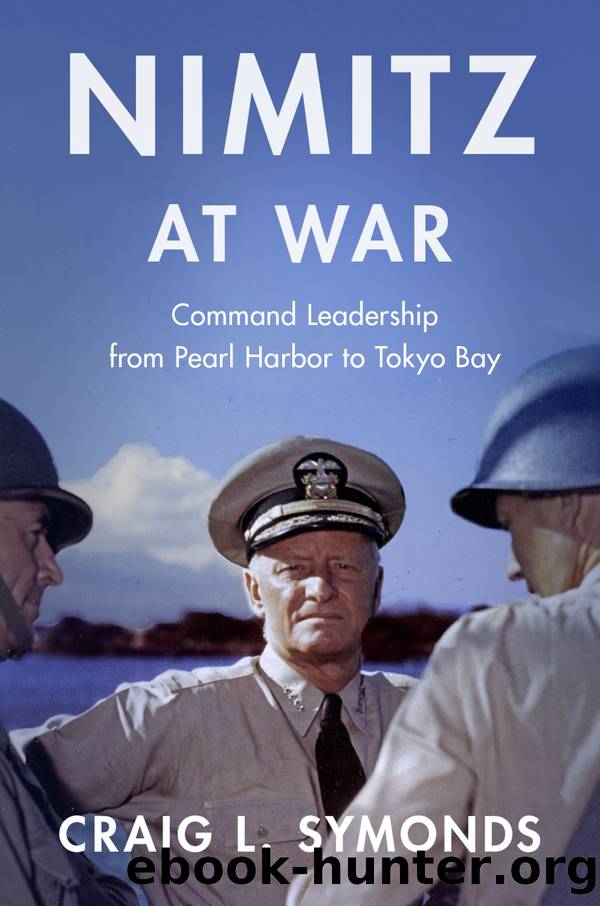Nimitz at War by Symonds Craig L.;

Author:Symonds, Craig L.;
Language: eng
Format: epub
Publisher: Oxford University Press, Incorporated
Published: 2022-07-15T00:00:00+00:00
Map 10: The Central Pacific Drive, November 1943âFebruary 1944
The planning went on literally around the clock. âWe all worked seven days a week,â a staffer recalled. âThere were a lot of people in the Headquarters 24 hours a dayâand it included the Admiral.â Spruance and Turner also worked eighteen-hour days. Holland Smith was at headquarters less often, though when he was there he was sometimes a discordant note. With round wire-rim glasses and a graying brush mustache, Smithâs physiognomy suggested that he was perpetually ready for a fight, and not just with the Japanese. Thin-skinned and confrontational, even his own staff grew weary of his complaints about ânever having enough of everything.â He grew especially quarrelsome when he thought someone was trying to usurp his authority. After learning that the Galvanic plan called for him to remain behind at Pearl Harbor, he charged off to Spruanceâs headquarters to demand that the orders be changed. His place was with his men, he insisted. He protested again when he saw that Turner was to exercise tactical command during the landings and asserted that âcommand of the landing force is a function of the Corps Commanderââthat is, himself. Again the orders were changed. Still suspicious, he concluded that the Navy leadershipâa group that certainly included Nimitzâwas making âa determined effort to cut me down to size and show the fountainhead of authority.â Like Towers, Holland Smith would have to be handled with patience and tolerance.4
One of Smithâs concerns was how his Marines were to get ashore at Tarawa. The landing craft designated to carry them from the transports to the beach were officially dubbed Landing Craft, Vehicle and Personnel (LCVPs), though they were universally known as Higgins boats after their designer, Andrew Jackson Higgins. With their drop-front bow, they were a vast improvement over the surfboats the Marines had used on Guadalcanal, yet Smith worried about them anyway. Betio had a coral shelf that extended a quarter mile or more out from its shoreline (see chapter 16). Even at high tide there was only about four feet of water over that shelf, and because the Higgins boats drew three feet fully loaded, the margin for error was small. Nimitz stipulated that the landing must take place at high tide, but Smith was not satisfied. Instead of the Higgins boats, he wanted the Marines carried to the beach in tracked landing vessels commonly called amphtracks, amtracks, or alligatorsâor, in the Navyâs acronym-laden lexicon, LVTs (Landing Vehicle, Tracked). Essentially amphibious tractors, LVTs could crawl over the coral no matter how shallow the water was. Turner did not think they were necessary, but Smith insisted. In his post-war memoir, he claimed that he told Turner that if he didnât get them he would refuse to carry out the landing. The problem was that there were only about a hundred LVTs in the theater, only seventy-five of which were operational. Fifty more of an improved type called water buffaloes (LVT-2) arrived in October just in time to take part.
Download
This site does not store any files on its server. We only index and link to content provided by other sites. Please contact the content providers to delete copyright contents if any and email us, we'll remove relevant links or contents immediately.
Harry Potter and the Goblet Of Fire by J.K. Rowling(3020)
Unfinished: A Memoir by Priyanka Chopra Jonas(2911)
Never by Ken Follett(2865)
The Man Who Died Twice by Richard Osman(2287)
Machine Learning at Scale with H2O by Gregory Keys | David Whiting(2252)
Fairy Tale by Stephen King(2056)
Will by Will Smith(2023)
Rationality by Steven Pinker(1757)
The Storyteller by Dave Grohl(1653)
The Dawn of Everything: A New History of Humanity by David Graeber & David Wengrow(1561)
The Dark Hours by Michael Connelly(1557)
The Stranger in the Lifeboat by Mitch Albom(1522)
Cloud Cuckoo Land by Anthony Doerr(1423)
The Becoming by Nora Roberts(1320)
Friends, Lovers, and the Big Terrible Thing by Matthew Perry(1315)
Einstein: His Life and Universe by Walter Isaacson(1308)
Crying in H Mart by Michelle Zauner(1306)
A Short History of War by Jeremy Black(1294)
New Morning Mercies: A Daily Gospel Devotional by Paul David Tripp(1292)
